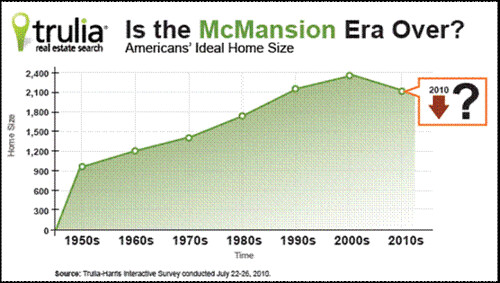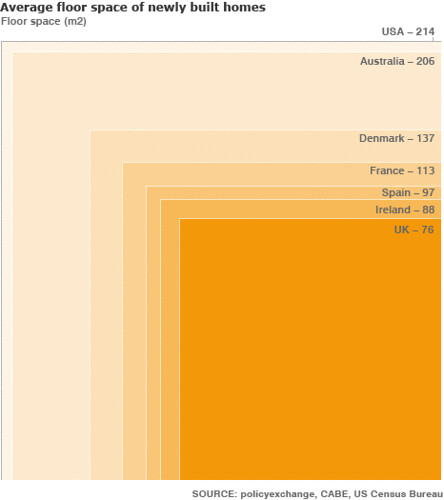Is the era of American McMansions over?
After many years of dramatically increasing home size in America - from an average of 983 square feet in the 1950s up to 2300 square feet in the 2000s, despite declining household sizes - the trend appears finally to be going in the other direction. The real estate research firm Trulia found in 2010, for example, that the median "ideal home size" for Americans had declined to around 2100 square feet. More than one-third of survey respondents reported that their ideal preference was lower than 2000 square feet.
This is consistent with the forecasts of the National Association of Home Builders. (See detailed findings here.) Data from the census are also consistent in direction with those from Trulio's survey, though more subtle in the degree of change: according to the census, the median size of a new US home in 2010 was 2,169 square feet, up from 1,525 sqare feet in 1973 but down from the 2007 peak of 2,277 square feet.
So, while the recent change has been observed in the industry for a few years now, the graphs shown with this post are the best I've seen yet to depict both how out-of-control home sizes had become and the more recent trend toward downsizing. The downsizing trend is expected to continue even after the economy recovers, according to a spokesperson from NAHB.
The census data also include trends in average home size, which runs somewhat larger than median home size:
The recent downsizing is still evident and consistent with the median size data and the Trulio report..
Not all with an interest in the matter seem willing to concede the point, however. Stanton Homes, a North Carolina-based builder whose website features large new homes, groups all homes from 1,800 to 2,300 square feet (a 28 percent increase) in one category to show that the portion of homes sold within that size range has remained the same since 2006, although it has declined slightly from the preceding seven years. Even Stanton's analysis, however, shows declines since 2006 in the portion of the total new housing market claimed by homes of 2,400 square feet and larger in size, with the sharpest drop in the largest (4,000 square feet and larger) category. Stanton's data also show a decided increase in the market share claimed by homes under 1,400 square feet since the mid-2000s.
The National Association of Realtors doesn't seem ready to concede the point, either. The organization finds significance in a comparison of survey data reportedly compiled by the American Institute of Architects. This is from a recent NAR article titled, "Are Home Sizes Finally Done Shrinking?":
"In the first quarter of 2010, nearly 60 percent of the architects surveyed in AIA's Home Design Trends Survey reported home sizes declining. Fast forward to the first quarter of 2011 and that number now has dropped to 52 percent, while 5 percent of architects are now reporting an increase in home sizes. Home sizes in the upper-end of the market, in particular, appear to be stabilizing ahead of more affordable entry-level homes."
Now, to me that sounds like a majority of architects in 2010 reported declining home sizes, and then a majority in 2011 reported even further decline. It also sounds like the Realtors are doing some wishful reporting (or at least headline-writing). But whatever.
Bear in mind that the census data include single-family, detached homes, semi-detached, and townhomes but do not include condominiums and apartments. If homes in multifamily configurations were counted, the average and median sizes would be considerably smaller and the trends perhaps more pronounced.
Meanwhile, new home size in the US is decidedly extravagant compared to that in other countries. A survey and data comparison conducted by the (now-defunct, unfortunately) British Commission on Architecture and the Built Environment found the size of an average new American home built in the 2000s to be approximately twice as large in floor space as one in Spain or France, and nearly three times as large as the average in the UK.
For more good graphs on the US trend from Trulia, go here.
Kaid Benfield writes (almost) daily about community, development, and the environment. For more posts, see his blog's home page. Please also visit NRDC's sustainable communities video channel.





